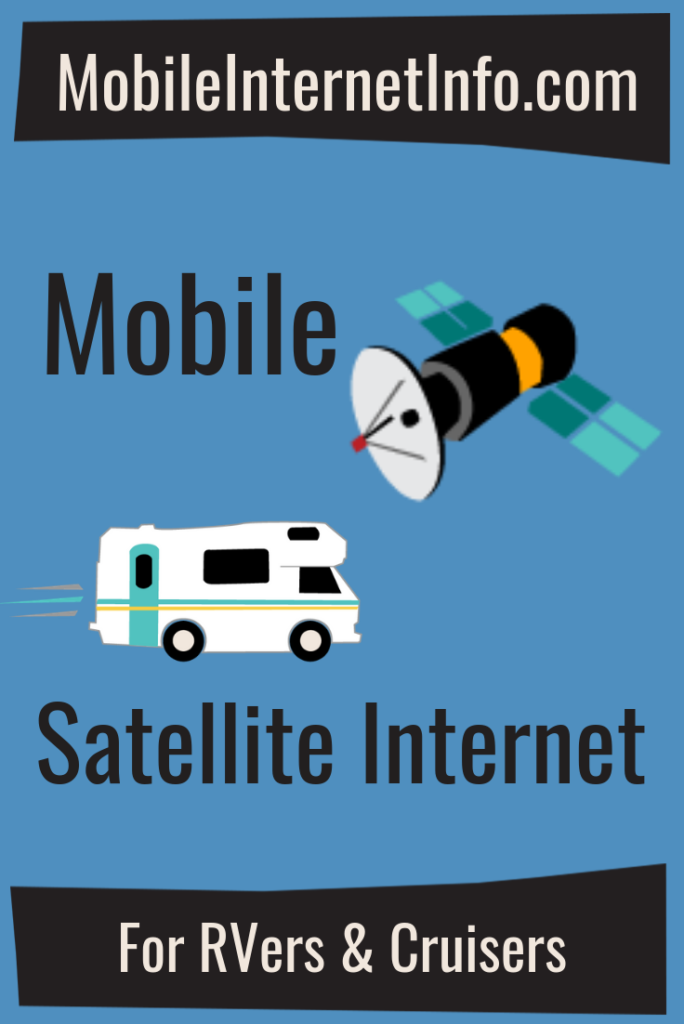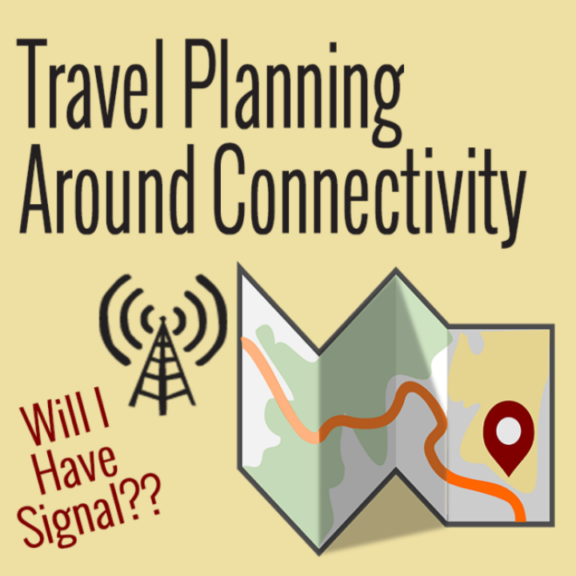
 There is something magical and futuristic about being online and connected in the absolute middle of nowhere.
There is something magical and futuristic about being online and connected in the absolute middle of nowhere.
The places far beyond Wi-Fi or cellular coverage, where only a satellite far above can keep you online.
As fun as it is to fantasize about connectivity everywhere, today’s geostationary satellite options come with many tradeoffs to consider.
Compared in particular to cellular service – current satellite internet options can be slower, with higher latency, and more costs than earthbound alternatives.
And the gear to get connected can be bulky and often requires cumbersome setup at each stop.
If you plan to focus your travels on being way out in the boonies where there are no other options, then the current challenges that come with satellite internet might be worthwhile.
But if you are hoping for a simple go-anywhere solution, satellite internet will likely frustrate you – at least for now.
But exciting stuff is currently on the launching pad – with companies like SpaceX speeding ahead to bring out new generations of low earth orbit satellite constellations that promise to bring affordable, high speed, low latency satellite coverage to the entire globe.
These options will hopefully prove to be mobile friendly for RVs and boats – with smaller sized receivers that will not require setup at each stop.
This is an exciting industry to watch, and we may begin to see limited consumer service coming online as early as late-2020!
But will low earth orbit satellite be the magical one-size-fits-all universal solution many are hoping for?
Read on to find out more about what is available today, and what is coming tomorrow.
This Guide Brought to You by Our Members
 We are honored to be able to present the basic sections of this guide for free without 3rd party advertising.
We are honored to be able to present the basic sections of this guide for free without 3rd party advertising.
This content is brought to you by funding from our premium members.
Our members have access to the entirety of this guide, interactive guidance, product reviews, alerts, vendor discounts and more.
If you’re a member, please log in above to see the member exclusive portions of this guide.
If mobile internet is an important part of your lifestyle, here are ways you can help:
Become a Member Support this Content
Traditional satellite internet options have relied on geostationary communication satellites that orbit in fixed locations 22,236 miles above the equator.
 The Iridium constellation (pictured here) consists of 66 satellites that are in synchronized orbits to provide truly global coverage. SpaceX’s Starlink constellation will require many times more – eventually tens-of-thousands of satellites!
The Iridium constellation (pictured here) consists of 66 satellites that are in synchronized orbits to provide truly global coverage. SpaceX’s Starlink constellation will require many times more – eventually tens-of-thousands of satellites!
But there is a new generation of satellite internet options on the horizon that will instead rely on constellations of multiple satellites working together in much lower orbits – potentially zooming by as little as 200 miles overhead.
The advantage of having satellites at lower orbits is that they are physically close enough to users on the ground to provide fast low-latency communications rivaling 4G – and even 5G – cellular.
But the disadvantage of a lower orbit satellite systems is that the satellites are always in motion in the sky – and it takes many satellites in coordinated orbits to guarantee that at least one is always passing overhead at any given time.
This means that you can’t roll out service after just a launch or two – you need to get enough satellites in orbit to provide uninterrupted coverage over your target areas.
There is a new space race underway to build next generation LEO constellations more ambitious than any that have ever even been imagined before – with hundreds, thousands, and even tens of thousands of satellites planned.
SpaceX’s Starlink has jumped into an early lead in this race, but there are other players too – and the next several years are going to be extremely exciting as these new networks (literally) get off the ground.
We are tracking all of these developments, and reporting on major milestones and announcements.
If you’re considering a satellite option for your mobile travels, it might be worth holding off on making any decisions until you consider all the latest details emerging on the new upcoming options.
Here’s our most current satellite internet news coverage:
In addition to these news stories, we are doing our best to keep the below content updated for all of the major players too.
 For most nomads, even with the upcoming low earth satellite options, satellite internet service is likely to be complementary to terrestrial options, not a full replacement.
For most nomads, even with the upcoming low earth satellite options, satellite internet service is likely to be complementary to terrestrial options, not a full replacement.
With all satellite systems, one challenge is unavoidable – to stay connected, you will always require a clear view of the sky.
Satellite internet requires clear line of sight between your receiver and the satellite to work – meaning you will not be able to get connected while parked under a shady tree, next to a tall building, or in a canyon.
LEO satellite constellations are NOT going to be a universal magical replacement for cellular service any time soon.
Even Elon Musk is clear that this is not his aim with his upcoming Starlink system:
“I wanna be clear, it’s not like Starlink is a huge threat to telcos. I want to be super clear. It is not. In fact it will be helpful to telcos because Starlink will serve the hardest to serve customers that telcos otherwise have trouble doing with landlines or even with cell radio stations, cell towers.”
So is satellite internet just a pointless fantasy for RVers and cruisers then?
 A beautiful shady campsite like this will always be a challenge for any satellite internet system.
A beautiful shady campsite like this will always be a challenge for any satellite internet system.
Not at all.
The future is bright with the new emerging satellite internet options, which can potentially make satellite a more integral part of a mobile internet arsenal – enabling low-latency broadband in many places where it was completely unavailable before.
But we predict few nomads will be able to rely solely on it.
For most RVers and cruisers – a mix of cellular, Wi-Fi and satellite will remain the key to staying connected everywhere.
And it is not just about where you can get connected – satellites experience congestion in areas with too many customers, just like cellular.
In more populated areas, there may still simply not be enough satellite bandwidth to go around.
In an urban or suburban area, the truth is that satellite will likely never be able to compete with fully built-out cellular infrastructure on the ground.
But on the other hand – in many remote areas it will never make sense to build a network of cell towers, and no matter how much cellular companies expand, there will ALWAYS be gaps in coverage.
And this is where satellite internet – current and future generations – makes the most sense.
The ideal connectivity future involves a mix of satellite and cellular, with service roaming seamlessly to the best connection possible wherever you happen to be.
Satellite internet can be confusing. It is important to make sure that you understand the basics.
Here are some of the most frequently asked questions answered and most confusing topics explained:
Satellite TV and Satellite Internet Are Not the Same!
 Receiving a signal from space isn’t particularly hard.
Receiving a signal from space isn’t particularly hard.
Transmitting a signal back to a satellite, on the other hand, is where it gets tricky.
Satellite TV dishes are receive-only devices and have no capability to transmit. Internet usage, however, requires two-way communication – and thus much larger and more complicated gear both on the ground and in space.
Some people get confused because they see satellite TV providers Dish Network and DirectTV (now owned by AT&T) advertising bundled packages that include internet service – but this is usually not satellite-provided internet.
These bundled plans are intended for stationary satellite TV consumers to combine their TV, wired internet, and phone bills into one. The satellite TV provider contracts out to local phone or partner cable companies to provide the actual internet service – usually relying on a hard-wired internet connection.
Customers in rural areas may get partnered with a residential stationary satellite internet option – ViaSat or Hughes.
In other words – not mobile friendly at all.
NOTE: Though the dishes look similar, most satellite internet systems are strictly for internet service, and are NOT compatible with any satellite TV services. If you also want satellite TV to go along with satellite internet, you’ll actually need a second dish!
Residential Satellite Service Generally Is NOT Mobile Friendly
There are two main residential satellite internet companies today: ViaSat and HughesNet.
There used to be more options, but other firms either went out of business or were acquired by these two companies.
Even if you’re getting satellite internet from a differently branded provider, it is likely one of these two companies behind the scenes providing the actual service.
Both of these residential satellite internet services are NOT designed for mobility – and moving locations usually requires a visit from a professional installer, and sometimes purchase of new equipment and a plan change.
Even if you had the tools to move and aim their gear at a new location, the network will detect you have moved and will not allow you to connect without an installer signing off that things are set up properly.
While you can usually get a dish permanently mounted at your summer and winter bases, and then just move the modem in between – we don’t consider either of these as viable connectivity options for users who move more than once or twice a year.
There are mobile satellite internet solutions out there presently suitable for mobile RVers, discussed later in this guide.
Has this guide been helpful so far?
Well.. there’s a lot more below available to our members – as well as dozens of other guides like this, videos, a classroom, forums, webinars and more. All specifically created for helping keep RVers, cruisers and nomads online.
Hopefully you’ve noticed that our content isn’t cluttered with 3rd party advertising, we’re not sponsored and we’re not reliant on selling you plans or gear to make our content possible.
We are instead community funded via our premium membership program – allowing us to focus on creating unbiased quality, in-depth, constantly updated content.
If mobile internet is an important part of your lifestyle, here are ways you can help:
Become a Member Support this Content
If you’re already a member, please log in to see the rest of this guide.
Here’s a sneak peak at the member exclusive topics in this guide:
Geostationary Satellite Concepts
Spot beam satellites, coverage maps, tripods vs roof mounts, latency and satellite communications.
Present Satellite Options for Mobile RVers
HughesNet and RVDataSat are the geostationary options available today, we go into more depth on both.
Satellite Communicators and Low Bandwidth Options
If you learn to think a bit differently – it is amazing how far (literally) 160 characters of text can take you. This section goes over options like Garmin inReach, Spot and Iridium Go.
Satellite Future: The Coming Revolution
Low earth orbit satellites are the future, and this section dives in to SpaceX’s Starlink, Amazon’s Project Kuiper, OneWeb, and Iridium Next/Certus – all satellite initiatives we are watching closely. We also cover developments on high-altitude balloons and drones that are designed to provide internet service.
Using current satellite technology for internet access comes with many trade-offs – including slower speeds, higher latency, and higher costs when compared to cellular options.
Unfortunately, satellite is not a simple, go-anywhere solution.
Choices will likely remain slim until the next generation of low earth orbit satellite systems start offering consumer service, which could reinvigorate satellite as a more common component of a mobile internet arsenal.
For most RVers and cruisers – a mix of cellular, Wi-Fi and satellite will remain the key to staying connected everywhere.
Here are all the satellite options we are tracking in the product center – ranging from full-on mobile solutions to very basic on-the-go options.
RV Note: For most RVers, the roof-mounted RVDataSat system and the tripod-based HughesNet Gen5 Spot Beam options will be the most interesting.
Marine Note: Satellite internet is currently a LOT trickier for boats unless you can mount the dish to a fixed dock. For boats rocking on the water, locking onto a broadband satellite in geosynchronous orbit is prohibitively difficult without a super-yacht budget. This tends to leave only the systems that do not require precise aiming as options, like satellite messengers, as worthy of consideration.
Click on each option in the grid for more details:
A handheld, weather resistant satellite communicator ‘non-data-hotspot’ that pairs with your phone or tablet for remote tracking & basic communication. Compatible with Zoleo plans – on the Iridium satellite network.
$199
Portable satellite communicator by Bivy
$349
Satellite hotspot offering two-way communication on the Iridium network and includes 24/7 SOS monitoring.
$350
Satellite communication system offering two-way communication on the Iridium network.
$399
Satellite powered Wi-Fi personal hotspot supporting voice & data.
$249
Handheld satellite communicators for remote tracking & communication.
$150 – 250
HughesNet’s “mobilized” generation of spot beam satellite service.
$1,000+
HughesNet Spot Beam Gen3 / Gen4
As of August 2017, HughesNet Gen4 “Jupiter” service is no longer available for new customers.
$1,000+
Roof mounted satellite internet system with unlimited usage plans.
$6500-$16K
Handheld satellite powered calling, text and data capabilities.
$699
An obsolete handheld satellite communicator for remote tracking & two-way text communication.
$299-$399
Related Guides
- Assessing Your Mobile Internet Needs
- Travel Planning Around Connectivity for RVers and Cruisers
- Thinking Outside the Box – Alternatives to Tradtional Mobile Internet Options
- Testing & Understanding Your Mobile Internet Speeds
Related Articles

01 Sep
Where To Go when Togo Plans Go – “AT&T Unlimited Adventure Plan” Replacement Ideas

26 Aug
Peplink’s New Pepwave Puma Antenna Line – With Sub-6 5G and Band 71 Support

26 Aug
Product Release: ZMax Connect – A T-Mobile Compatible Hotspot With Antenna Ports by ZTE

21 Aug
Cricket Wireless Introduces 100GB Simply Data Plan for $90/mo for Hotspots & Routers AND Adds 5G Access to Some Plans

Understanding & Optimizing Your Cellular Data Performance

Approaching Your Mobile Internet Solution & Sample Setups

Travel Planning Around Connectivity for RVers and Cruisers
Join our ‘Library Desk’:
Internet for RVers & Cruisers Facebook Group
We cross post news articles and guides, and can help point you in the right direction to our content here on the resource center.
It is with gratitude to our premium members that we’re able to offer our free content – and for that, they also have access our private Q&A areas for more in-depth guidance.
Stay in the Know
We’re constantly tracking the industry and analyzing new developments for mobile travelers. If you’d like to receive updates, we offer several ways:
- Subscribe to our free monthly newsletter
- Follow our News Stories
- Subscribe to our YouTube Channel













